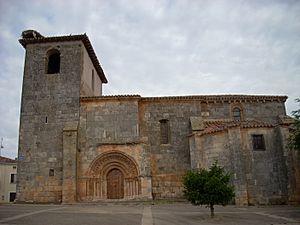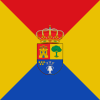Madrigal del Monte facts for kids
Quick facts for kids
Madrigal del Monte
|
|||
|---|---|---|---|

San Andrés church
|
|||
|
|||
| Country | Spain | ||
| Autonomous community | |||
| Province | |||
| Comarca | Arlanza | ||
| Area | |||
| • Total | 27 km2 (10 sq mi) | ||
| Elevation | 935 m (3,068 ft) | ||
| Population
(2018)
|
|||
| • Total | 147 | ||
| • Density | 5.44/km2 (14.10/sq mi) | ||
| Time zone | UTC+1 (CET) | ||
| • Summer (DST) | UTC+2 (CEST) | ||
| Postal code |
09320
|
||
| Website | http://www.madrigaldelmonte.es/ | ||
Madrigal del Monte is a small and charming town located in the province of Burgos, which is part of the Castile and León region in Spain. It's a municipality, meaning it's a local area with its own government. This town is a great example of the many interesting places you can find in rural Spain.
Contents
Discover Madrigal del Monte: A Spanish Town
Madrigal del Monte is a quiet place with a rich history. It's known for its peaceful atmosphere and traditional Spanish feel. The town is surrounded by beautiful landscapes, typical of the Burgos province.
Where is Madrigal del Monte?
This municipality is found in the northern part of Spain. It's specifically in the province of Burgos, which is one of nine provinces in the large region of Castile and León. The town is also part of a smaller area called Arlanza. It sits at an elevation of about 935 meters (around 3,068 feet) above sea level.
How Many People Live Here?
Madrigal del Monte is a very small community. According to a census from 2018, the town had a population of 147 people. This means it's a place where everyone likely knows each other! In 2004, the population was a bit higher, with 209 inhabitants.
Symbols of the Town
Like many towns, Madrigal del Monte has its own special symbols. These include a flag and a shield, which represent the town's history and identity. You can see these symbols in the infobox at the top of this page.
The San Andrés Church
One of the important buildings in Madrigal del Monte is the San Andrés church. This church is a key part of the town's history and architecture. It's a place where people gather and is often a central landmark in Spanish towns. You can see a picture of it in the infobox.
See also
 In Spanish: Madrigal del Monte para niños
In Spanish: Madrigal del Monte para niños



